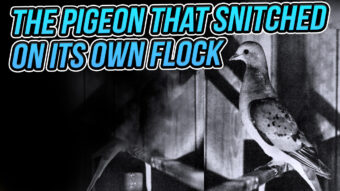
In May 1850, Chief Simon Pokagon, of the Potawatomi tribe was camping near the Manistee River in Michigan when he beheld an astonishing sight:
“One morning on leaving my wigwam I was startled by hearing a gurgling, rumbling sound, as though an army of horses laden with sleigh bells was advancing through the deep forests towards me. As I listened more intently I concluded that instead of the tramping of horses it was distant thunder; and yet the morning was clear, calm and beautiful. Nearer and nearer came the strange commingling sounds of sleigh bells, mixed with the rumbling of an approaching storm. While I gazed in wonder and astonishment, I beheld moving toward me in an unbroken front millions of pigeons, the first I had seen that season. They passed like a cloud through the branches of the high trees, through the underbrush and over the ground, apparently overturning every leaf.”
The gigantic flock Chief Pokagon witnessed was composed of Ectopistes migratorius, better known as the Passenger Pigeon. Once the most abundant birds in North America – and possibly the world – at their peak Passenger Pigeons numbered some 5 billion. Their range extended from central Ontario, Quebec, and Nova Scotia south to Texas, Louisiana, Alabama, Georgia, and Florida, with their main nesting areas stretching from the Great Lakes east to New York. A highly nomadic and communal species, Passenger pigeons migrated across the continent in vast flocks in search of beechnuts, acorns, chestnuts, and other seeds to eats and hardwood trees to roost and nest in. These flocks were often hundreds of millions or even billions strong, and were an awesome sight to behold. One flock observed over Southern Ontario in 1866 was 800 kilometres long and took 14 hours to pass overhead, while in 1855 a flock passing over Columbus, Ohio was so large and dense it blotted out the midday sun:
“As the watchers stared, the hum increased to a mighty throbbing. Now everyone was out of the houses and stores, looking apprehensively at the growing cloud, which was blotting out the rays of the sun. Children screamed and ran for home. Women gathered their long skirts and hurried for the shelter of stores. Horses bolted. A few people mumbled frightened words about the approach of the millennium, and several dropped on their knees and prayed. [When the flock passed two hours later], the town looked ghostly in the now-bright sunlight that illuminated a world plated with pigeon ejecta.”
To give an idea of how inconceivably abundant these birds were, American nature writer and poet Christopher Cokinos has calculated that if the entire population of Passenger Pigeons were to have flown single-file, the flock would have stretched around the globe 22 times. Yet little more than a half-century later, there would not be a single Passenger Pigeon left alive anywhere on earth.
When European settlers first arrived on the North American continent, Passenger Pigeons provided a conveniently abundant source of protein. Indeed, even waving a long pole in the low-flying flocks was guaranteed to kill a few birds. But so vast were the flocks that such subsistence hunting posed little threat to the birds’ survival. However, the massive post-Civil War migration of settlers into the American West drove up demand for food, creating a brand-new industry of professional pigeon hunters. And right from the start, business was booming, as the Wisconsin newspaper the Kilbourn City Mirror reported in 1871:
“Hardly a train arrives that does not bring hunters or trappers. Hotels are full, coopers are busy making barrels, and men, women, and children are active in packing the birds or filling the barrels. They are shipped to all places on the railroad, and to Milwaukee, Chicago, St. Louis, Cincinnati, Philadelphia, New York, and Boston.”
Commercial pigeon hunters used every method at their disposal to kill the greatest number of birds possible. They shot at them with shotguns, trapped them in nets, set fire to their roosts, gassed them out of the trees with burning sulphur, and even poisoned them with corn soaked in alcohol. And it is among these varied methods that we find the most commonly-accepted origin for the term “stool pigeon” – and any animal lovers or squeamish types in the audience might want to turn off the video now.
Still here? Well, don’t say we didn’t warn you…
One particularly gruesome method used by pigeon hunters was to take a live pigeon, sew its eyelids shut, and nail it to a stool. Its cries of distress would attract nearby pigeons, who would subsequently be killed. It did not take long for this practice to be associated with people who betray their own kind. However, while this is the most oft-cited origin for the term, there are several issues with this explanation which have led lexicographers to suspect it of being a false etymology.
For starters, while “stool pigeon” was used to mean “informant” as early as 1828, when it appeared in the first edition of Webster’s Dictionary, explicit references to the hunting practice do not appear until the 1870s, with its first known appearance being in M. Schele de Vere’s 1871 dictionary Americanisms; the English of the New World:
“Stool-Pigeon… it means the pigeon, with its eyes stitched up, fastened on a stool, which can be moved up and down by the hidden fowler.”
This 40-year gap suggests that either the two uses of the term developed independently, or that the hunting practice was retroactively applied as the origin of a much older term.
There are also more practical issues with the common etymology of “stool pigeon.” For example, it is dubious that hunters would go to the trouble of carrying a wooden stool into the bush solely for the purpose of hunting. Some etymologists thus suggest that the “stool” in “stool pigeon” actually derives from the 16th-century stoale, meaning the base or stump of a tree – a far likelier place for a decoy pigeon to be nailed. Still others suggest that the term has nothing to do with platforms and is instead derived from the French word estale, used to describe a pigeon used to entice a hawk into a net. Indeed, by the early 15th Century the term had entered the English language as stale, used to describe someone who baits or entrap another. It is this meaning of the word that the sorcerer Prospero employs in Shakespeare’s play The Tempest, when he commands the spirit Ariel:
“The trumpery in my house, go bring it hither for stale to catch these thieves.”
An alternate spelling of stale was stall, which came to describe a pickpocket’s accomplice who distracted a mark while they were robbed. This usage survives to this day in the phrase “stall for time.” As for the other part of the expression, the term “pigeon” has been used since at least the 16th century to describe someone who is foolish or gullible. Thus it is possible that the term “stool pigeon” never had anything to do with hunting, and instead simply combined two preexisting slang words to describe a gullible person used as a decoy by criminals. Whatever the case, by the 1840s the term “stool pigeon” was ill-understood to mean “informant”, and had acquired the verb forms “stooling” or “to stool.” Later in the 1920s, the term was shortened to simply “stoolie.”
But while the cruel 1870s hunting practice may not have given us a colourful piece of criminal slang, it – along with the myriad other tactics used by commercial pigeon hunters – contributed to a slaughter on a scale almost imaginable today. During a single hunting season in Petoskey, Michigan, in 1878, some 50,000 birds were killed every single day for nearly 5 months straight. The birds were so abundant that they sold for as little as fifty cents a dozen. Yet people continued to believe that Pigeon stocks were inexhaustible, with no less a figure than great ornithologist John James Audubon stating that:
“… nothing but the gradual diminution of our forests can accomplish their decrease as they not infrequently quadruple their numbers yearly, and always at least double it.”
And when, in 1857, a bill was brought before the Ohio State Legislature seeking protection for the Passenger Pigeon, a selected committee of the Senate dismissed the petition as unnecessary, concluding that:
“The passenger pigeon needs no protection. Wonderfully prolific, having the vast forests of the North as its breeding grounds, traveling hundreds of miles in search of food, it is here today and elsewhere tomorrow, and no ordinary destruction can lessen them, or be missed from the myriads that are yearly produced.”
Similar efforts at protection also failed, and the slaughter continued unabated. It was not until the 1890s, when Passenger pigeon flocks had started to become noticeably depleted, that serious conservation legislation was passed in states like Michigan and Pennsylvania. But it was already too late. Passenger pigeon numbers were in freefall, the billions-strong flocks of just a few decades ago now a thing of the past. By the turn of the 20th Century, the bird had completely vanished in the wild, with the last known wild example, a female nicknamed “Buttons”, being shot in Pike County, Ohio in 1900. In 1903, the only Passenger Pigeons left in the world belonged to a captive flock kept by Professor Charles Whitman of the University of Chicago. Whitman attempted to breed his pigeons by getting common Rock Doves to foster their eggs, but was unsuccessful. By 1906, he was down to only five birds. The end finally came on September 1, 1914, when the last known survivor, a 29-year-old female named Martha, died in her cage at the Cincinnati Zoo. The Passenger Pigeon was no more.
But how did this happen? How did the most abundant bird in North America, whose flocks were so enormous they blotted out the sun, go from a population of billions to zero within the span of a human lifetime? While the unchecked commercial slaughter that raged from the 1860s onwards was the main cause, but there were a number of additional factors that hastened the Passenger Pigeon’s rapid demise. Among these, as John James Audubon had predicted, was the large-scale destruction of the birds’ natural habitat. Passenger Pigeons relied on large stands of oak, chestnut, and beech trees in which to roost, nest, and feed – stands which were being systematically cut down to clear land for agriculture and supply timber for industry. The birds large numbers also worked against them. The Pigeons’ iconic behaviour of travelling in giant flocks evolved as a survival strategy known as predator satiation – the idea that no group of predators, no matter how large, could possibly kill enough members of a flock to have any impact on the total population. Unfortunately, this behaviour made the birds extremely vulnerable to human hunters, making them easy to slaughter in large numbers. Worse still, Passenger Pigeons were extremely social and gregarious birds, requiring large flocks to carry out mating rituals and raise their young. Once a flock’s size dropped below a certain threshold – whether due to hunting or habitat loss – its members became unable to breed successfully, dooming the flock to inevitable decline and death. This is why efforts to breed the last captive Passenger Pigeons were unsuccessful, and why recent proposals to resurrect the Passenger Pigeon through Jurassic Park-style cloning are likewise doomed to fail: the birds simply cannot breed successfully in small groups. Furthermore, the vast stands of food-bearing trees needed to support large Passenger Pigeon flocks had already disappeared by the late 19th Century. Thus, even if all hunting had stopped in the 1890s, it is likely that Passenger Pigeon numbers would still have continued to decline. A similar fate is expected befall another heavily overexploited species: the Atlantic Codfish, Gadus morhua. By 1992, overfishing had driven cod stocks on the Grand Banks to less than 1% of their estimated peak, prompting the Canadian government to impose a total moratorium on cod fishing. But it was too little, too late; while the moratorium has been in place for over 30 years, cod numbers are still steadily decreasing, with the Atlantic Cod expected to go extinct by 2050. Both cases clearly demonstrate the principle outlined by naturalist Paul Ehrlich that:
“…it is not always necessary to kill the last pair of a species to force it to extinction.”
Recent genetic evidence has suggested that Passenger Pigeons may also have been victims of extremely poor timing. An analysis conducted by Pen-Jen Shaner and colleagues from National Taiwan Normal University revealed a surprisingly low degree of genetic diversity in preserved Passenger Pigeon specimens collected across North America indicating that the late 19th Century Pigeon population grew very rapidly from a handful of flocks. This suggests that Passenger Pigeons were a so-called “breakout species” like Australian Plague Locusts or Arctic Lemmings, whose populations explode in times of plenty only to crash once local food resources are depleted. It is thus possible that the mass commercial slaughter of Passenger Pigeons coincided with a natural downswing in population numbers, further hastening their extinction. However, later analysis by Beth Shapiro of the University of California Santa Cruz has challenged this assumption, revealing instead that Passenger Pigeon populations were, in fact, large and stable since the last ice age. Still, rapid population growth may still have played a role in the birds’ ultimate demise. One theory posits that the expansion of agriculture and the relocation of Indigenous peoples across North America both provided Passenger Pigeons with a new, abundant source of food and relieved traditional hunting pressures, allowing the population to skyrocket right before the advent of large-scale hunting.
But whatever the specific factors, what is undeniable is that the rapid and catastrophic extinction of the Passenger Pigeon was ultimately the result of human action, and that this ecological tragedy was responsible for the birth of the modern conservation movement. In 1900, Republican Congressman John F. Lacey of Iowa introduced United States’s first wildlife-protection law, which banned the interstate transportation of unlawfully killed game. In his speech to the House of Representatives, Lacey stated:
“The wild pigeon, formerly in flocks of millions, has entirely disappeared from the face of the earth. We have given an awful exhibition of slaughter and destruction, which may serve as a warning to all mankind. Let us now give an example of wise conservation of what remains of the gifts of nature.”
Later that year, Lacey’s bill was signed into law. This legislation was further strengthened in 1913 by the Weeks McLean Act and again in 1918 by the Migratory Bird Act, which protected not only birds but also their eggs, nests, and feathers. While conservation efforts are far stronger today than they were in the early 1900s, the unchecked destruction and pollution of natural habitats around the world continue to put thousands of species at risk of extinction. The destruction of the Passenger Pigeon should serve as a poignant reminder to learn from the mistakes of the past, for, in the words of naturalist and explorer William Beebe:
“The beauty and genius of a work of art may be reconceived, though its first material expression be destroyed; a vanished harmony may yet again inspire the composer; but when the last individual of a race of living beings breathes no more, another heaven and another earth must pass before such a one can be again.”
If you liked this article, you might also enjoy our new popular podcast, The BrainFood Show (iTunes, Spotify, Google Play Music, Feed), as well as:
- The Fascinating Origins of Everyday Things (Part 4)
- The Interesting Origins of the Words “Geek” and “Nerd”
- The Origins of the Mathematical Convention of Using “X” as the Unknown
- Is Spider Blood Really Blue, The Origins of the Necktie, The Nazi Super Cannon and More
Billions to None…the Extinction of the Passenger Pigeon, John James Audubon Center at Mill Grove, https://johnjames.audubon.org/conservation/billions-none-extinction-passenger-pigeon
Yeoman, Barry, Why the Passenger Pigeon Went Extinct, Audubon Society Magazine, May-June 2014, https://www.audubon.org/magazine/may-june-2014/why-passenger-pigeon-went-extinct
Why Did the Passenger Pigeon Go Extinct? Forbes, https://www.forbes.com/sites/grrlscientist/2017/11/24/why-did-the-passenger-pigeon-go-extinct/?sh=70c1849a2a9d
Passenger Pigeon Extinction: It’s Complicated, Medium, June 16, 2014, https://grrlscientist.medium.com/passenger-pigeon-extinction-its-complicated-grrlscientist-3f8e8ad3b6de
Greenfieldboyce, Nell, Why Did the Passenger Pigeon Go Extinct? The Answer Might Lie in Their Toes, NPR, November 16, 2017, https://www.npr.org/sections/thetwo-way/2017/11/16/564597936/why-did-the-passenger-pigeon-go-extinct-the-answer-might-lie-in-their-toes
Biello, David, 3 Billion to Zero: What Happened to the Passenger Pigeon? Scientific American, June 27, 2014, https://www.scientificamerican.com/article/3-billion-to-zero-what-happened-to-the-passenger-pigeon/
The Passenger Pigeon, Smithsonian Magazine, https://www.si.edu/spotlight/passenger-pigeon
Kovalchik, Kara, Why is an Informant Called a “Stool Pigeon”? Mental Floss, August 26, 2016, https://www.mentalfloss.com/article/83619/why-informant-called-stool-pigeon
Stool Pigeon, World Wide Words, https://www.worldwidewords.org/qa/qa-sto2.htm
What’s the Origin of the Phrase “Stool Pigeon”? The Phrase Finder, https://ift.tt/zSOeLIY
The Word Guy: Dropping a Dime on the Origin of “Stool Pigeon”, Tribune Live, December 4, 2015, https://ift.tt/WVxUI85
The post The Horrifying Origin of the Term “Stool Pigeon” appeared first on Today I Found Out.



0 comments:
Post a Comment
Please ,
Don't enter span link